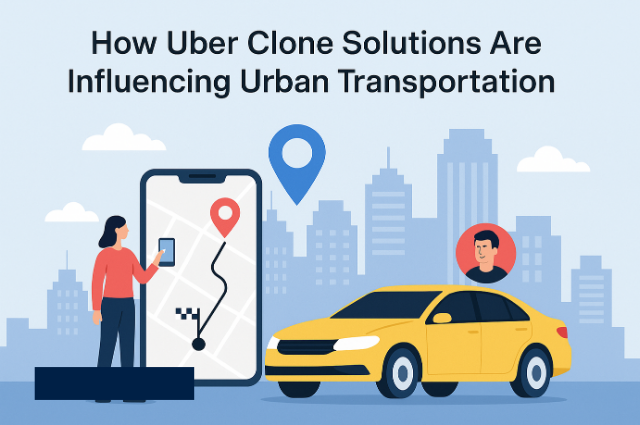
In today’s urban landscape, ride-hailing is no longer just a convenience—it’s an essential part of modern mobility. Entrepreneurs eyeing this space in 2025 face a unique opportunity: delivering localized, reliable, and scalable ride-hailing services that cater to specific regional needs. Instead of starting from scratch, many founders are turning to Uber clone scripts—customizable platforms that provide all the essential components needed to launch fast and scale smart.
This comprehensive guide walks you through every step of building a scalable Uber clone app, from strategy to tech stack and market expansion. Whether you’re an aspiring mobility founder or an app development strategist, this roadmap sets you up for long-term success.
1. Understand the Core Architecture of an Uber Clone App
To scale effectively, your app must be built on a strong, modular architecture. A standard Uber clone app typically includes:
- Rider App: Trip booking, real-time tracking, fare estimator, payments, ratings
- Driver App: Trip requests, navigation, earnings dashboard, availability toggle
- Admin Panel: Zone management, fleet control, user analytics, dynamic pricing
- Dispatcher Panel (Optional): Manual bookings and driver assignment for high-touch services
Scalability begins with choosing a script that allows customization without breaking the backend. Look for microservices architecture or modular monoliths that separate features by function—making it easier to add services like food delivery or rentals later.
2. Choose the Right Uber Clone Script Provider
The backbone of your ride-hailing business is the clone app development company you partner with. Evaluate providers based on:
- Source code ownership (do you get full rights?)
- Tech stack (Flutter, Kotlin, Node.js, etc.)
- Feature depth (real-time tracking, SOS, surge pricing, multi-language/currency)
- Post-launch support and upgrade commitments
- Customization scope and timelines
- Scalability tools like geo-fencing, multi-city dashboards, and fleet segmentation
You want a tech partner—not just a vendor. Vet their client history and ensure they can support growth from a single city to regional dominance.
3. Map Out Your MVP for Local Launch
Before aiming for multi-city operations, define your Minimum Viable Product (MVP) and launch zone. For early testing and feedback, your MVP should include:
- Core trip booking and driver matching
- Live ride tracking and digital fare calculator
- In-app payments and wallet recharge
- Support/chat system
- Driver onboarding and KYC verification
Start small—one service zone, a defined fleet, and targeted users. Use real-world insights to fine-tune UX, operations, and fleet incentives before expanding.
4. Prioritize Scalable Features from Day One
To future-proof your app, plan for features that support expansion and system stability:
- Zone-based control panels: So local managers can adjust fares and driver rules
- Modular onboarding: For new drivers, admins, or delivery agents
- Multi-service toggles: Add delivery, rentals, or EV rides without code overhauls
- API integrations: For payment, maps, analytics, CRM, or fleet partners
- Multilingual and multi-currency support: Crucial for cross-border scaling
Choosing scalability early ensures your backend grows with your market—not against it.
5. Build a Back-End Infrastructure That Can Scale
Even the best front-end UI is useless without a robust backend. To handle thousands (and eventually millions) of rides, your system should be:
- Cloud-deployable (AWS, Google Cloud, or Azure)
- Load-balanced for traffic spikes
- Built for concurrent requests (real-time map syncing, chat, GPS tracking)
- Secured with authentication, encryption, and compliance protocols
- Monitored with analytics dashboards and failover alerts
Consider Docker and Kubernetes for containerized deployments that support feature rollouts without disrupting live service.
6. Focus on Brand Differentiation
While the tech stack powers your business, branding makes it memorable. Even clone-based apps must look, sound, and feel distinct. Customize:
- Logo, colors, fonts, and iconography
- App UI flows and tone of messaging
- App Store listing, screenshots, and pitch copy
- Onboarding animations and walkthroughs
Your market may have five ride apps—but only one will truly connect with users. Build that identity from the start.
7. Implement Smart Driver and Fleet Management Tools
Your drivers are your lifeline. A scalable app must support:
- Real-time earnings dashboards
- Tiered incentive systems (bonuses, rewards)
- Flexible payout schedules (weekly/daily/on-demand)
- Rating-based filters and deactivation protocols
- Driver support ticket systems
Integrate tools that keep your driver community active, satisfied, and loyal—especially as you grow into new geographies.
8. Roll Out Gradually Using Zone-Based Scaling
Scaling isn’t just technical—it’s geographic. Use a zone-based rollout model, where each city or neighborhood is treated like a mini startup. Customize:
- Local base fares and surge rules
- Regional promotions and referral offers
- Compliance with transportation laws
- Language preferences and communication style
- Local fleet partner onboarding
Manage each zone from a centralized dashboard, but empower local managers or franchisees with partial control.
9. Leverage Analytics for Strategic Expansion
Data is your best growth advisor. Use analytics tools in the admin panel to track:
- Ride frequency and heatmaps
- Driver acceptance/cancellation ratios
- Payment method preferences
- Trip duration and earnings benchmarks
- Churn rates and reactivation metrics
Data-driven scaling ensures that every new zone performs better than the last.
10. Offer Room for Multi-Service Expansion
Modern Uber clone apps aren’t limited to ride-hailing. Build your MVP with expansion in mind:
- Parcel delivery: Local logistics and e-commerce integration
- Food/grocery delivery: Partner with restaurants or stores
- Taxi pooling or subscription rides
- EV category with charging station maps
- Corporate ride dashboards
With modular service toggles, you can evolve from a transport startup to a multi-service super app.
Conclusion
Building a scalable Uber clone app in 2025 is more than launching a basic ride-hailing platform—it’s about architecting a future-ready mobility business. From choosing the right Uber clone script to partnering with a reliable clone app development company, every decision you make should reinforce scalability, flexibility, and user-centricity.
Start small, scale smart, and iterate boldly. Because the future of ride-hailing doesn’t belong to those with the biggest budget—it belongs to those with the best blueprint.






